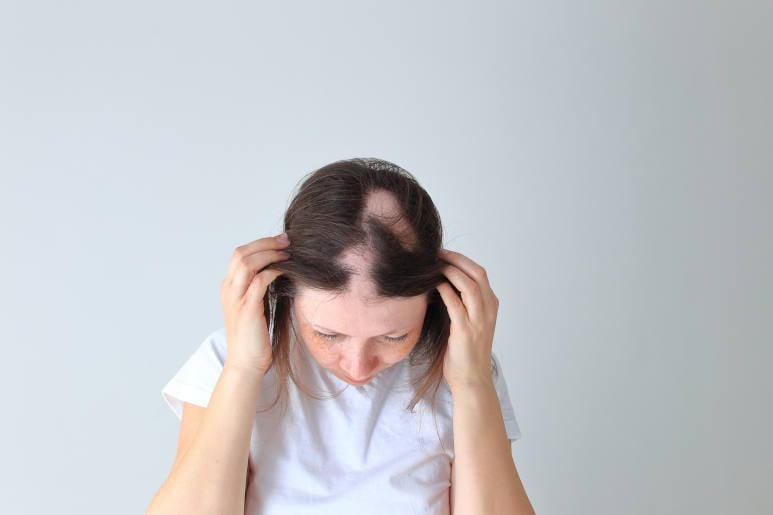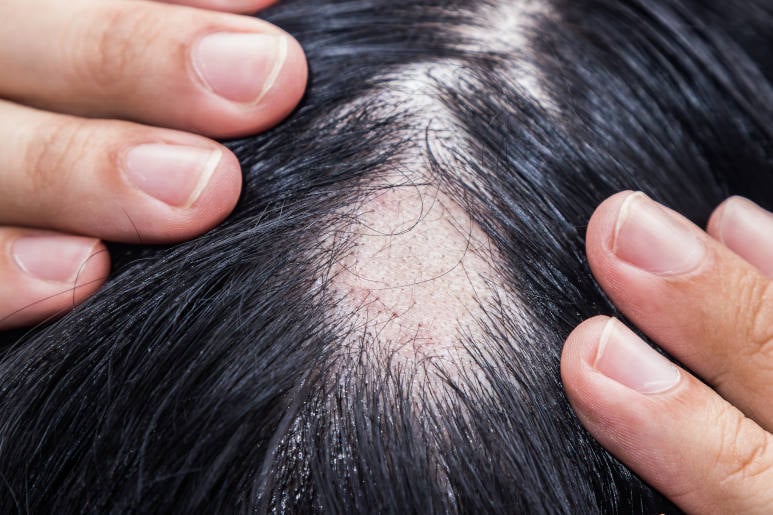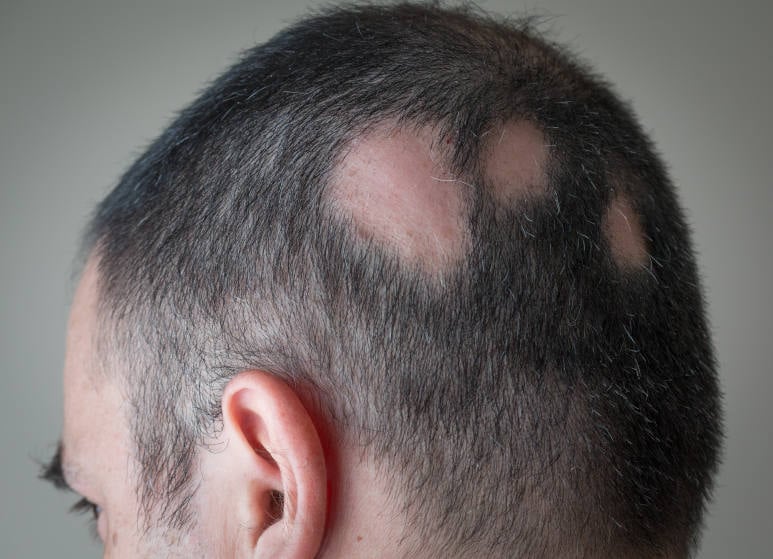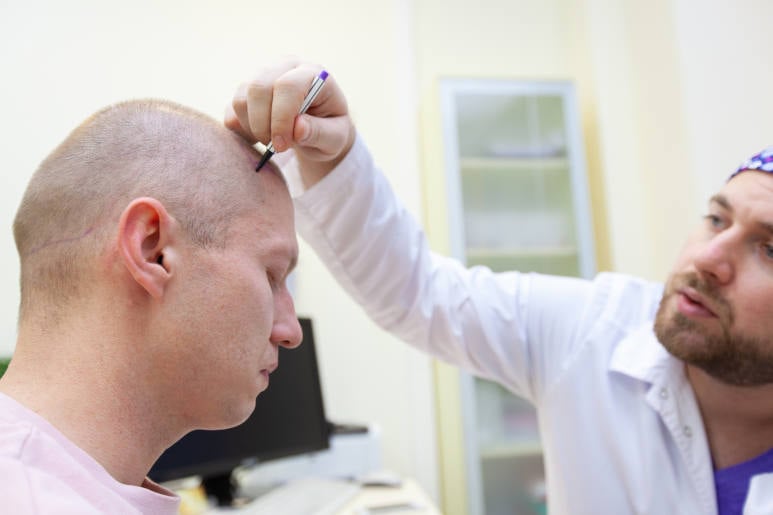
What Can I Do To Stop My Alopecia Areata Symptoms?
Alopecia areata (AA) affects 1-2 percent of the British population, accounting for 2% of new dermatological NHS outpatients each year.
Scientists have been studying the relationship between AA and autoimmune diseases, coeliac disease, and what causes alopecia areata for many years.
New studies show that patients who received auto immunotherapy and changed their diets experienced successful hair regrowth. We’ll go over these findings in greater depth below.
Summary
- Who Is Affected by Alopecia Areata?
- What Are the Symptoms?
- Is There a Cure for Alopecia Areata?
- Conclusion
Who Is Affected by Alopecia Areata?

Alopecia areata (AA) is a type of alopecia can affect people of any gender or race at any age. However, symptoms usually appear in men and women during adolescence. In fact, up to 60% of people with AA will have their first bald spot by the age of 20.
Alopecia in children is also a possibility. If a child notices their first bald spot, it is an early warning sign that they will develop AA later in life. You should observe whether you have alopecia areata triggers for the hair loss, such as a stressful situation or a traumatic event – as this could be what triggers future “flare-ups”.
How long an episode of AA lasts depends on the individual. To explain, this is dependent on other medical conditions that are contributing to the symptoms of hair loss.
What Triggers Areata?
Alopecia areata is a type of alopecia that is caused by an autoimmune disease. Autoimmune diseases occur when your immune system attacks itself. It does this because it cannot distinguish between your own cells and foreign cells.
These diseases come in a variety of forms with varying degrees of severity; naturally, some conditions are more treatable than others.
What Autoimmune Diseases Cause Alopecia Areata?
A study by Muller and Winkelmann discovered that people with autoimmune disorders frequently developed alopecia areata that formed organ-specific autoantibodies. These antibodies are pathogenic in both disorders. As a result, there is a strong link between other autoimmune diseases and areata alopecia.
Atopy has been reported to occur in patients with AA. Furthermore, atopic disorders (such as atopic dermatitis) have been reported to occur with an incidence of 1-52% in these patients.
One of the main systemic associations of autoimmune diseases are thyroid conditions (such as Graves’ disease). Thyroid disease was found in 8-28% of areata alopecia patients who participated in this medical study, according to the International Journal of Dermatology.
Examples of autoimmune diseases include:
- Atopic dermatitis,
- Rheumatoid arthritis,
- Psoriasis,
- Vitiligo,
- Lupus erythematosus,
- Thyroid diseases
- Coeliac disease,
- Anaemia,
- Diabetes,
- Graves’ disease,
- and Addison disease.
What Are the Symptoms?

Areata is distinguished visually because hairs fall out in small oval-shaped patches. These bald spots can appear anywhere on your body, including your legs to your eyebrows and even your beard. However, it more obviously affects the hair on your scalp.
Symptoms of alopecia areata can develop into a total loss of eyebrows, eyelashes, your beard and all of your body hair. When this occurs, AA develops into alopecia totalis and alopecia universalis.
Bald patches are the most common symptom however, other accompanying alopecia areata symptoms are:
- Exclamation mark hairs – In alopecia areata, exclamation mark hair is a main symptom. These hairs are narrow at the root and get wider (hence the name). They are often found surrounding the bald patches.
- Brittle, split and/or pitted finger nails – In most cases of areata nail pitting is present – giving the nails an orange peel-like texture. Ophiasis can also be seen on your nails, which is a discolouration.
- Patchy hair loss – Visible coin-sized bald spots on the scalp or the body.
- Diffuse alopecia areata – Diffuse alopecia is a rare form of the condition where the hair loss is sparse rather than in defined circular patches.
- Frontal fibrosing alopecia – This type of alopecia forms in a band-like pattern at the forehead and temples and often presents as red scarred or raised skin in a zigzag pattern.
Does Areata Cause Pain?
Alopecia areata doesn’t typically cause pain, however it can be painful to live with as it can induce stress and anxiety. Since the symptoms are so visible, it is a distressing condition that can have a negative impact on your psychological health.
Stress and anxiety aggravate your hair loss situation. Therefore, we recommend joining a support group with other alopecia patients such as forums, as well as seeking support from your friends and family.
Things to avoid when you have alopecia areata
Since you no longer have hair covering your skin in certain spots, your skin is more susceptible to the elements. To explain, the skin in these areas will be more sensitive to the sun, which can cause further damage. Therefore, you should avoid direct sunlight to these areas.
It’s important to apply a high SPF sunscreen to alopecia bald spots and wear a hat or a scarf.
Avoid gluten! Since 1995 there have been studies about the link between coeliac disease and alopecia areata. Reports have shown that AA symptoms have improved on a gluten-free diet.
Is There a Cure for Alopecia Areata?

Very little is known about alopecia areata causes, and therefore a cure hasn’t been established yet. Although there isn’t a cure, there are various alopecia areata treatments that have seen successful hair regrowth.
Choosing the right treatments for alopecia areata also depends on how severe your condition is and the causes of alopecia areata. For example, doctors will try different doses of medication and monitor how your hair responds. Through this “trial and error” process, you can find the right medication and dosage that helps your hair grow back and how to stop alopecia areata from spreading.
4 Alopecia Areata Treatments:
- Topical immunotherapy – this is the best documented treatment for alopecia areata. Dinitrochlorobenzene (DNCB), squaric acid dibutylester (SADBE), and diphencyprone (DPCP) are the recommended treatments. Diphencyprone has seen a success rate between 17-60% for patients with alopecia totalis or universalis, and 88-100% in patients with patchy AA.
- Topical Minoxidil – this is available as a solution or a foam in 2% or 5%. Only the 2% minoxidil should be used by women, as a stronger dose can cause unwanted facial hair growth.
- Corticosteroid injections (steroid injections) – Steroid injections can take place every 4-6 weeks and patients can notice hair regrowth after 1-2 months of treatment.
- Topical Corticosteroids (steroid cream) – Many patients use this alopecia areata treatment cream because applying the steroid cream directly to the affected areas has seen significant hair growth improvements for many AA patients.
Alopecia areata hair growth signs appear as a gradual improvement in the density of hair within the bald spots. One clear indication of alopecia areata regrowth signs is new hairs beginning to sprout up where it was previously bald. This is a clear sign that the treatment of alopecia areata you’re using is working.
Can a Hair Transplant Cure Alopecia Areata?
A hair transplant is rarely recommended for people with alopecia areata. This is because your autoimmune system will continue to attack your hair follicles even if they are in a new location. Therefore, if you transplanted hairs into the bald patches, it’s likely that they will fall out just like the hair that was there before.
This will also speed up the hair loss process because you are moving unaffected hair into an area where your body has been attacking the hair follicles.
Conclusion
Although the condition can occur all over your body, it is more noticeable by others when it’s on your scalp. Thus, it can have a profound effect on your self-esteem and your quality of life. While there isn’t a cure for AA there are effective treatments available including diphencyprone (DPCP) and other immunotherapy medications.
FAQ
What lifestyle changes can help manage alopecia areata?
Managing stress through techniques like meditation, yoga, and regular exercise can help reduce flare-ups. Additionally, maintaining a healthy diet rich in vitamins and minerals supports overall hair health.
Can children outgrow alopecia areata?
In some cases, children may outgrow alopecia areata as they age, especially if the condition is mild. However, it can persist or recur throughout their lifetime.
Are there any specific triggers that can worsen alopecia areata?
Common triggers include physical or emotional stress, illness, hormonal changes, and exposure to certain environmental factors. Identifying and avoiding these triggers can help manage the condition.
What support resources are available for individuals with alopecia areata?
Support resources include online forums, support groups, and counselling services. Connecting with others who have similar experiences can provide emotional support and practical advice.
Can hair regrow naturally without treatment in cases of alopecia areata?
Yes, hair can regrow naturally in some cases of alopecia areata. However, regrowth can be unpredictable, and medical treatments may be necessary for more severe cases.


